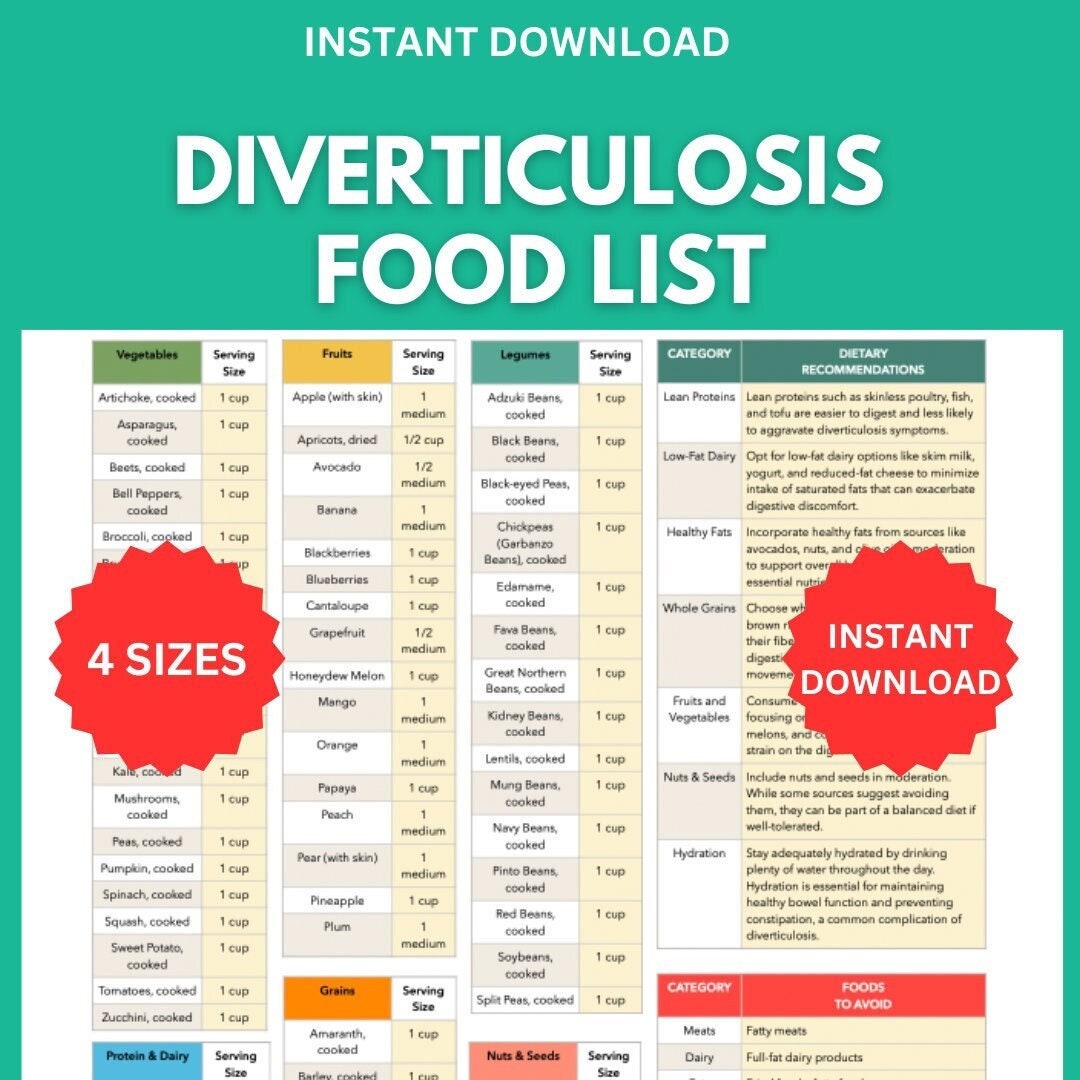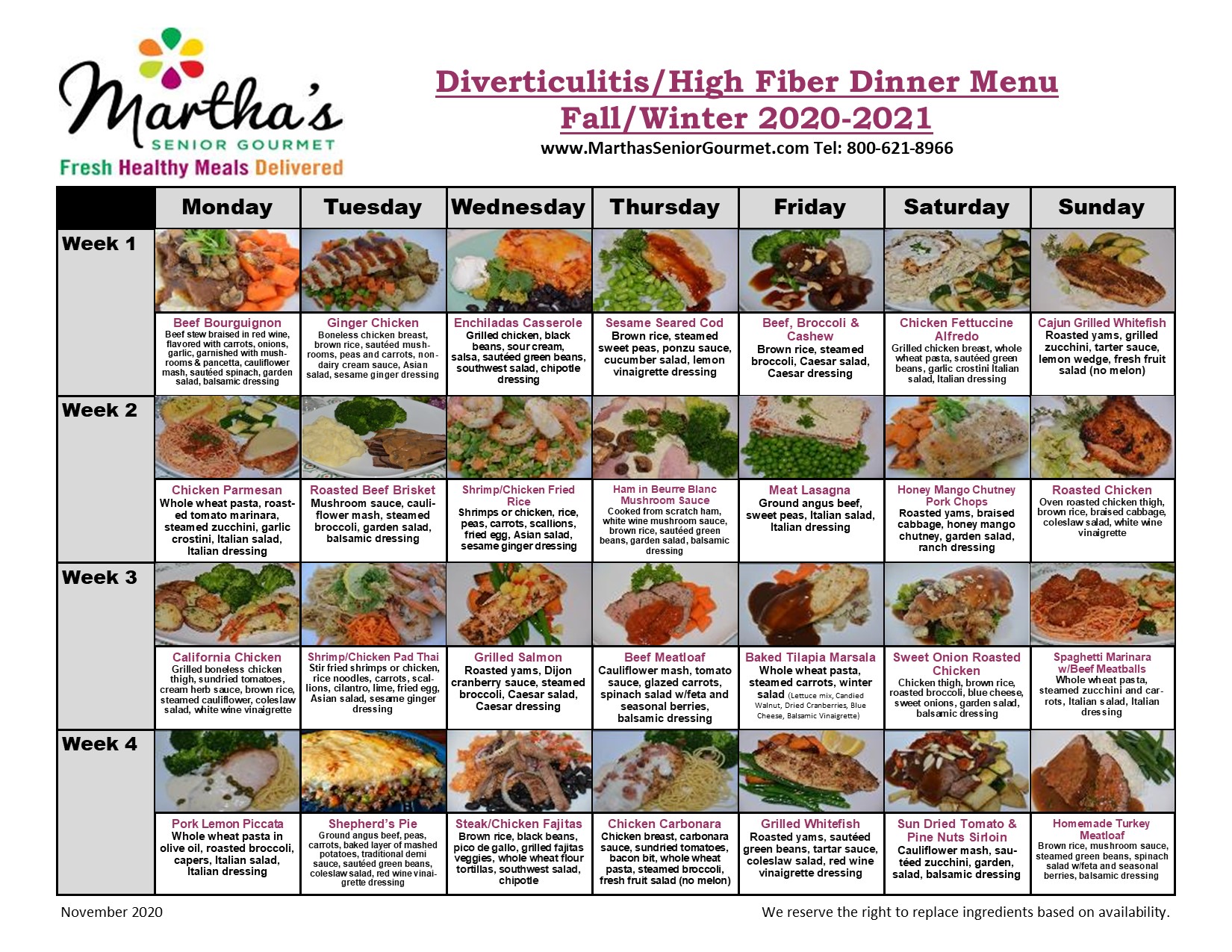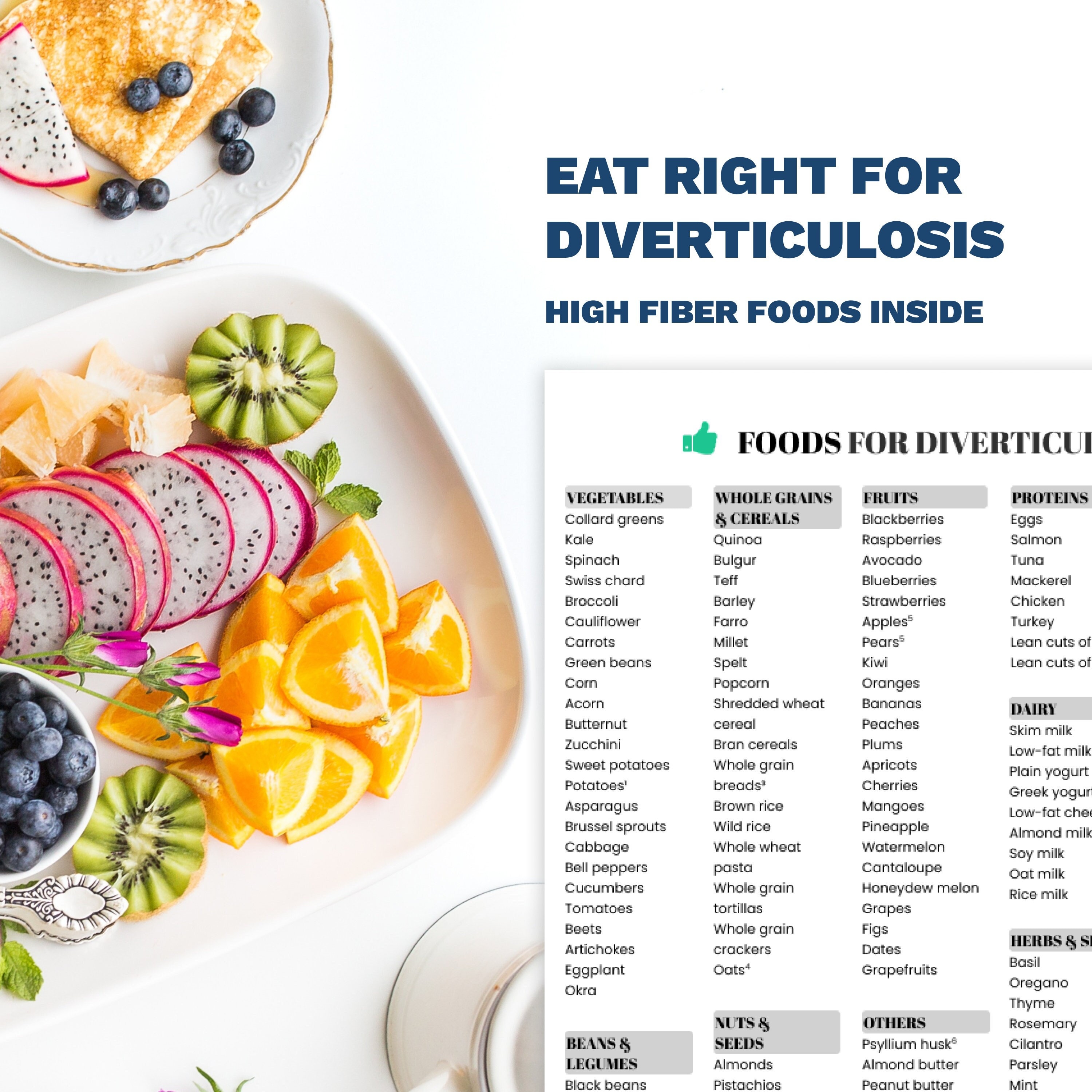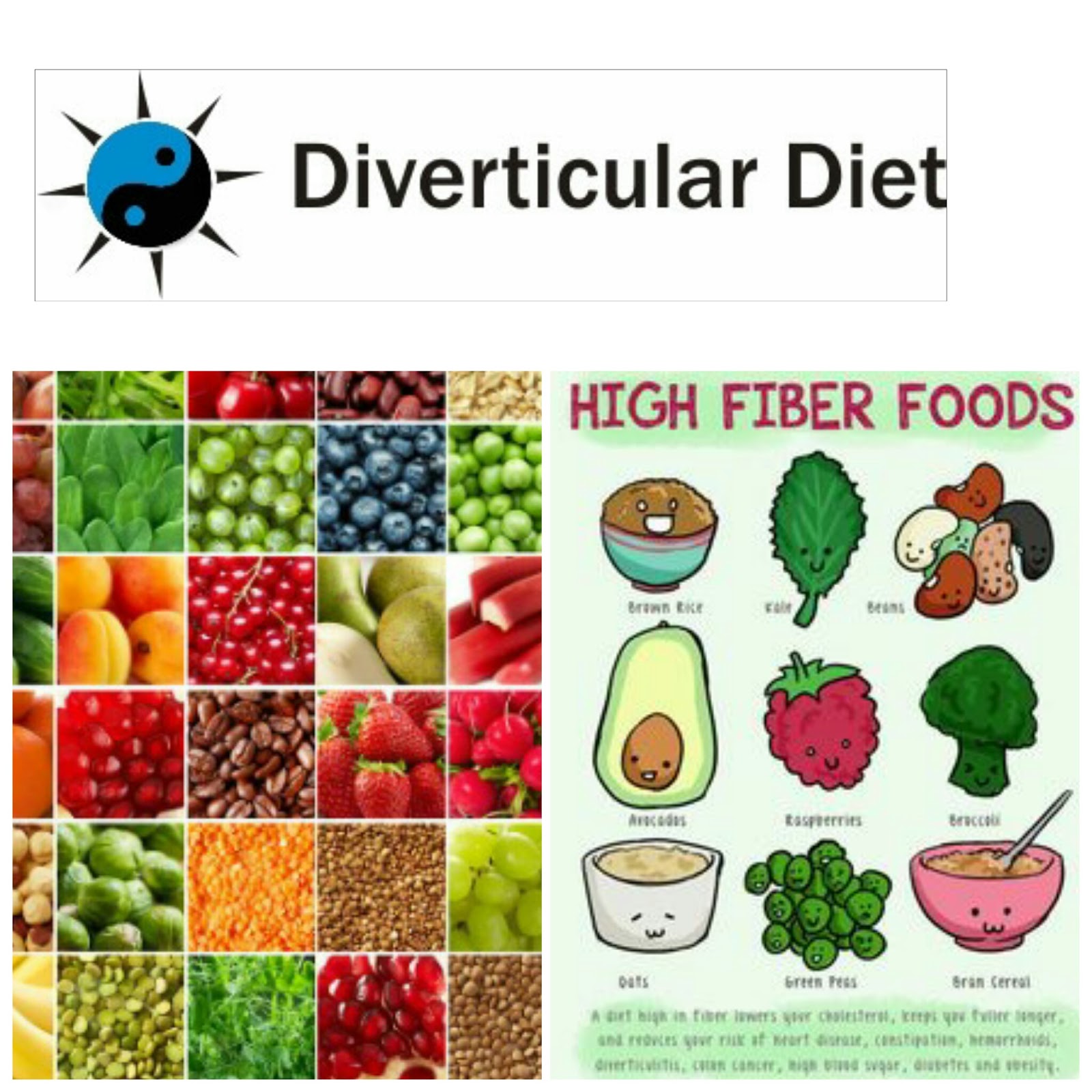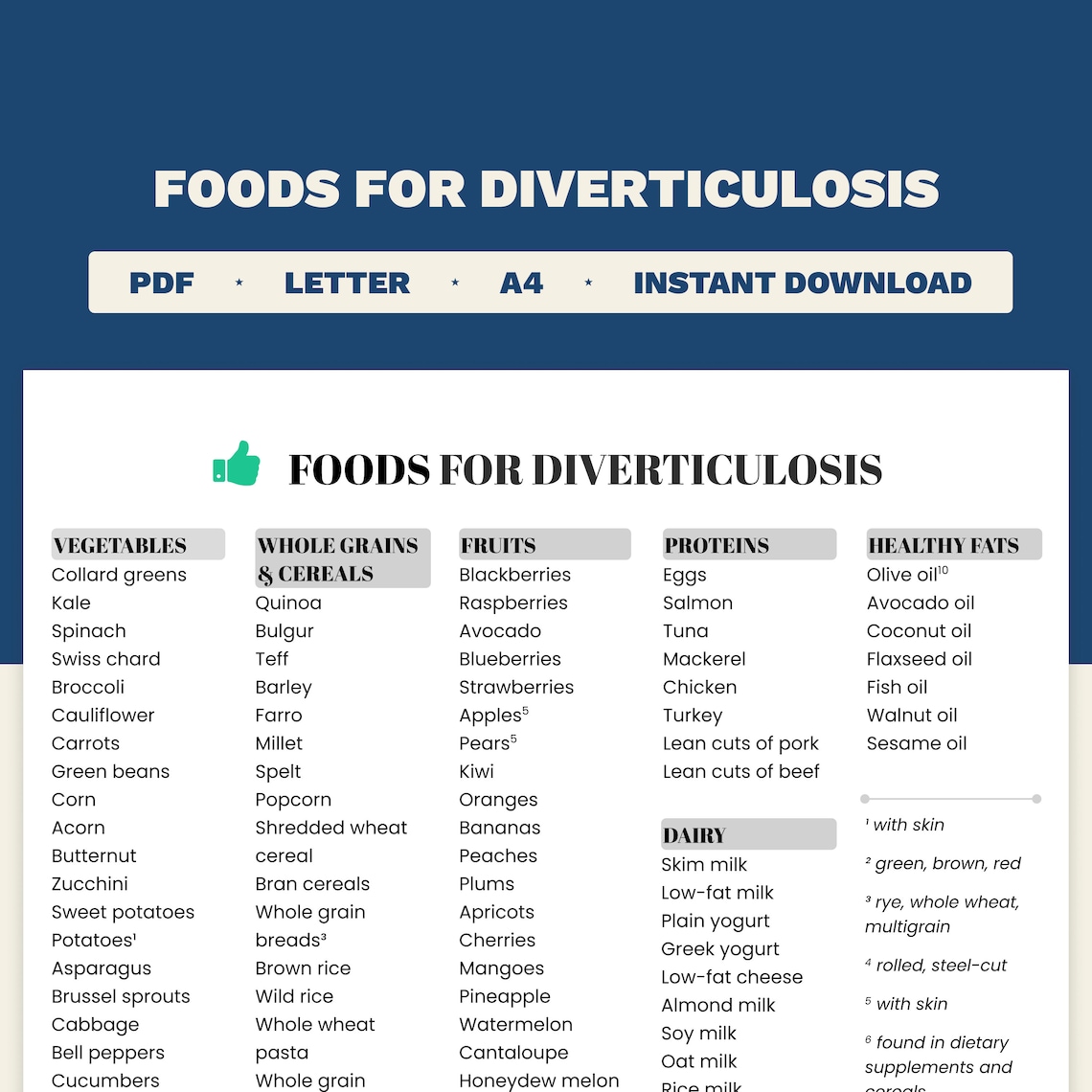Printable Diverticulosis Diet
Printable Diverticulosis Diet - With diverticulitis, what you eat and drink can depend on your symptoms. During episodes of diverticulitis, it is helpful to eat a relatively bland diet avoiding irritant foods. On a clear liquid diet, you can eat: This resource will help you choose what to eat to help manage diverticular disease. It occurs when small pouches form in your intestine and push outward, like tiny balloons, at weak spots in your colon. A high fiber diet is still overall recommended to reduce risk of diverticulosis as well as diverticulitis (inflamed diverticula) that may develop from diverticulosis. Traditionally, patients with diverticular disease have been advised to follow a high fibre diet to manage their symptoms. Even though about 58% of people over the age of 60 have this condition, most people never experience symptoms. Enjoy a healthy diet that includes a wide variety of foods. However, if you are experiencing symptoms, particularly diarrhoea. How is a diverticulosis diet different from a regular diet? During episodes of diverticulitis, it is helpful to eat a relatively bland diet avoiding irritant foods. It occurs when small pouches form in your intestine and push outward, like tiny balloons, at weak spots in your colon. Enjoy a healthy diet that includes a wide variety of foods. Diverticulosis is a common condition that affects your large intestine. Diverticular disease is when small pockets develop in the lining of the. A diet low in fiber may help reduce gi discomfort during flares of diverticulitis by reducing frequency of stools. On a clear liquid diet, you can eat: Coffee and tea without milk or nondairy creamer. Traditionally, patients with diverticular disease have been advised to follow a high fibre diet to manage their symptoms. Even though about 58% of people over the age of 60 have this condition, most people never experience symptoms. Diverticulosis is a common condition that affects your large intestine. These are high fibre foods such as onions, fruit and vegetable skins, seeds and nuts. How is a diverticulosis diet different from a regular diet? Patients find that a diet food. The average american diet includes only about 12 to 15 grams (g) of fiber a. Individuals experiencing episodes of diverticulitis are recommended to adjust their diet as it has been proven to significantly improve most of their symptoms. It is recommended that patients with diverticular disease eat a healthy, balanced diet including good sources of fibre from wholegrains, fruit and. Adding more fibre to your diet may help reduce the chances of developing symptoms or other complications of diverticulitis in the future. It is recommended that patients with diverticular disease eat a healthy, balanced diet including good sources of fibre from wholegrains, fruit and vegetables and ensure having adequate fluid. While a diet high in fiber may help prevent diverticulosis. Coffee and tea without milk or nondairy creamer. This resource will help you choose what to eat to help manage diverticular disease. With diverticulitis, what you eat and drink can depend on your symptoms. It is recommended that patients with diverticular disease eat a healthy, balanced diet including good sources of fibre from wholegrains, fruit and vegetables and ensure having. On a clear liquid diet, you can eat: Enjoy a healthy diet that includes a wide variety of foods. The following steps may help reduce the risk of getting diverticular disease or a flare up of diverticulitis. Patients find that a diet food list for diverticulitis including examples of clear liquids, bland foods, and foods with fiber, helps when selecting. These are high fibre foods such as onions, fruit and vegetable skins, seeds and nuts. However, if you are experiencing symptoms, particularly diarrhoea. How is a diverticulosis diet different from a regular diet? The average american diet includes only about 12 to 15 grams (g) of fiber a. With diverticulitis, what you eat and drink can depend on your symptoms. A diet low in fiber may help reduce gi discomfort during flares of diverticulitis by reducing frequency of stools. It is recommended that patients with diverticular disease eat a healthy, balanced diet including good sources of fibre from wholegrains, fruit and vegetables and ensure having adequate fluid. It is a common belief that when you have. This resource will help. With diverticulitis, what you eat and drink can depend on your symptoms. Traditionally, patients with diverticular disease have been advised to follow a high fibre diet to manage their symptoms. It occurs when small pouches form in your intestine and push outward, like tiny balloons, at weak spots in your colon. Patients find that a diet food list for diverticulitis. During episodes of diverticulitis, it is helpful to eat a relatively bland diet avoiding irritant foods. This resource will help you choose what to eat to help manage diverticular disease. Eat higher fibre foods often fibre may help prevent diverticula (sacs or pouches in the colon) from forming and may make symptoms. Even though about 58% of people over the. Eat higher fibre foods often fibre may help prevent diverticula (sacs or pouches in the colon) from forming and may make symptoms. These are high fibre foods such as onions, fruit and vegetable skins, seeds and nuts. Patients find that a diet food list for diverticulitis including examples of clear liquids, bland foods, and foods with fiber, helps when selecting. The average american diet includes only about 12 to 15 grams (g) of fiber a. Adding more fibre to your diet may help reduce the chances of developing symptoms or other complications of diverticulitis in the future. Coffee and tea without milk or nondairy creamer. The disease was first noticed in the united states in the. Diverticulosis is a common condition that affects your large intestine. Enjoy a healthy diet that includes a wide variety of foods. While a diet high in fiber may help prevent diverticulosis and thus diverticulitis; Eat higher fibre foods often fibre may help prevent diverticula (sacs or pouches in the colon) from forming and may make symptoms. Enjoy a healthy diet that includes a wide variety of foods. It occurs when small pouches form in your intestine and push outward, like tiny balloons, at weak spots in your colon. During episodes of diverticulitis, it is helpful to eat a relatively bland diet avoiding irritant foods. Patients find that a diet food list for diverticulitis including examples of clear liquids, bland foods, and foods with fiber, helps when selecting what to eat during episodes of discomfort. Diverticular disease is when small pockets develop in the lining of the. How is a diverticulosis diet different from a regular diet? A diet low in fiber may help reduce gi discomfort during flares of diverticulitis by reducing frequency of stools. These are high fibre foods such as onions, fruit and vegetable skins, seeds and nuts.Diverticulosis Food List, Printable Diverticulosis Food List With Gut
Printable Diverticulosis Food Diverticulitis Food Chart
Printable Diverticulosis Diet Handout
Printable Diverticulosis Food Diverticulitis Food Chart
Printable Diverticulosis Food Diverticulitis Food Chart
Comprehensive Foods for Diverticulosis List Highfiber Diet Guide for
Printable Diverticulosis Food Diverticulitis Food Chart
Printable Diverticulosis Diet Handout
Diverticulosis Food Diverticulitis Food Chart
Comprehensive Foods for Diverticulosis List Highfiber Diet Guide for
On A Clear Liquid Diet, You Can Eat:
Individuals Experiencing Episodes Of Diverticulitis Are Recommended To Adjust Their Diet As It Has Been Proven To Significantly Improve Most Of Their Symptoms.
Even Though About 58% Of People Over The Age Of 60 Have This Condition, Most People Never Experience Symptoms.
The Following Steps May Help Reduce The Risk Of Getting Diverticular Disease Or A Flare Up Of Diverticulitis.
Related Post:
